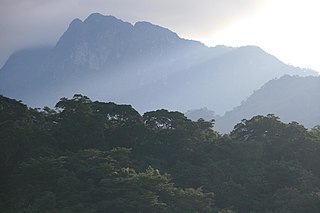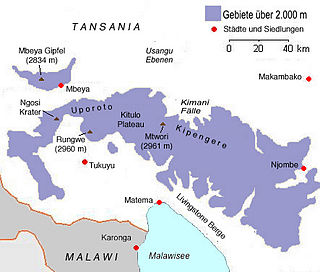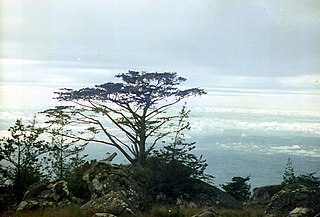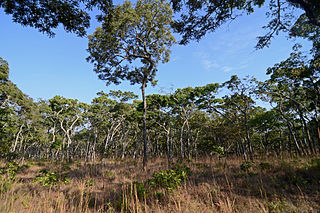
The Eastern Highlands, also known as the Manica Highlands, is a mountain range on the border of Zimbabwe and Mozambique. The Eastern Highlands extend north and south for about 300 kilometres (190 mi) through Zimbabwe's Manicaland Province and Mozambique's Manica Province.
The Nguru Mountains are a mountain range in Morogoro Region, Tanzania, Africa. The Nguru Mountains are part of the Eastern Arc Mountains. The mountains are predominantly covered with rainforest, home to 83 species of birds and African violets. There are a number of forest reserves in the mountains.
Nyika National Park lies in the northeast of Zambia, on the western edge of the Nyika Plateau, which is one of the highest parts of the country and most of which lies in neighbouring Malawi.
The Viphya Mountains, also known as the Viphya Plateau or Viphya Highlands, are a mountain range in Malawi's Northern Region.
The Kipengere Range, also known as the Livingstone Mountains, lies entirely in Njombe Region in southwest Tanzania at the northern end of Lake Nyasa. Near Lake Nyasa they are known as the Kinga Mountains. It is a plateau-like ridge of mountains running southeastwards from the basin of the Great Ruaha River in the north to that of the Ruhuhu River in the south, and forms part of the eastern escarpment of the East African Rift. The range is mostly clad in montane grasslands, renowned for their botanical diversity and displays of flowers, with montane evergreen forests mostly in stream valleys.

The Udzungwa Mountains are a mountain range in south-central Tanzania. The mountains are mostly within Iringa Region, south of Tanzania's capital Dodoma. The Udzungwa Mountains are part of the Eastern Arc Mountains, and are home to a biodiverse community of flora and fauna with large numbers of endemic species.
The Kirk Range is a plateau in southwestern Malawi, extending in a north-south direction and skirting the southwestern shore of Lake Malawi and the western border of the Shire River valley. The range includes several peaks higher than 1800 meters in elevation. The northern end of the range overlooks the Central Region plateau and Lake Malawi. The range forms the Malawi-Mozambique border, and the divide between the watersheds of Mozambique's Revúboé River to the west and Malawi's Shire River to the east. The Lisungwe and Mkulumadzi (Wamkulumadzi) rivers are tributaries of the Shire that originate in the Kirk Range.

Mount Rungwe is a volcanic mountain in Mbeya Region, in Tanzania's Southern Highlands. At an altitude of 2,981 metres (9,780 ft), it is southern Tanzania's second-highest peak. Rungwe's volcano is currently inactive.

The black and red bush squirrel is a species of rodent in the family Sciuridae occurring in Malawi, Tanzania, and Zambia. In Malawi, it is found in Misuku Hills and Nyika Plateau and in Tanzania Poroto Mountains and Mount Rungwe; it has not been found in Zambia where it was expected to occur in Mafinga Hills and Makutu Mountains. Its natural habitats are subtropical or tropical moist montane forest, subtropical or tropical dry shrubland, and subtropical or tropical dry lowland grassland. It may be threatened by habitat loss.

The South Malawi montane forest-grassland mosaic is an ecoregion of Malawi.

The densely forested Central Zambezian miombo woodlands that cut across southern central Africa are one of the largest ecoregions on the continent and home to a great variety of wildlife, including many large mammals.

(TANAPA))
The Southern Highlands is a highland region in southwestern Tanzania, at the northern end of Lake Malawi. The highlands include portions of Mbeya, Njombe, Rukwa, Ruvuma, and Songwe regions, bordering Malawi, Mozambique, and Zambia. Mbeya is the largest city in the highlands.

Ntchisi Mountain is a mountain in central Malawi. It is located in Ntchisi District, east of the town of Ntchisi.

Chipata Mountain is a mountain in central Malawi. It is located in Nkhotakota District, north of the town of Mbobo.
The Misuku Hills are a mountain range in Malawi's Northern Region.
The Ufipa Plateau is a highland in southwestern Tanzania. It lies mostly in Rukwa Region, near the border with Zambia. The plateau is named for the Fipa people who inhabit it.

The Umalila Mountains are a mountain range in southern Tanzania, on the border with Malawi. The Umalila Mountains are part of Tanzania's Southern Highlands.

The Ukaguru Mountains are a mountain range in central Tanzania. The mountains are in Morogoro region, east of Tanzania's capital Dodoma. The mountains are named for the Kaguru people. The Ukaguru Mountains are part of the Eastern Arc Mountains, and are home to a biodiverse community of flora and fauna with large numbers of endemic species.










